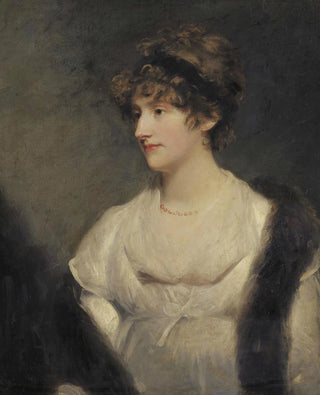Art print | Portrait of Jane Frere Lady Orde - John Hoppner


View from behind

Frame (optional)
Introduction captivante
The "Portrait of Jane Frere Lady Orde" by John Hoppner is an iconic artwork that transports the viewer into the intimacy of a bygone era. This painting, which captures the grace and elegance of its subject, evokes not only Lady Orde's physical beauty but also the richness of her character. Hoppner, known for his ability to seize the essence of his models, succeeds here in creating an atmosphere of delicacy and psychological depth. Jane's gaze, imbued with gentleness and reflection, seems to invite the viewer to delve into her inner world, making this art print truly captivating.
Style and uniqueness of the work
John Hoppner's style is distinguished by its finesse and mastery of nuances. In the portrait of Jane Frere, he deploys a subtle color palette, where warm and soft tones blend harmoniously. The texture of the paint, almost tangible, brings life to the drapes of the sitter's dress, while the play of light accentuates the delicate features of her face. Hoppner manages to establish a perfect balance between realism and romanticism, thus creating an image that transcends the simple portrait to become a true art print. The composition, centered on Lady Orde's face, invites prolonged contemplation, revealing new facets of her personality with each look.
The artist and his influence
John Hoppner, born in 1758, is one of the most renowned portraitists of his time, often compared to figures such as Sir Joshua Reynolds. His artistic journey, marked by rigorous training and innate sensitivity to human representation, allowed him to carve out a prominent place in the world of British art. Hoppner evolved with his era, integrating neoclassical elements while preserving his own distinctive style. His influence is felt not only through his works but also through the teaching he provided to young artists. The "Portrait of Jane Frere Lady Orde" testifies to his skill in capturing the spirit of his contemporaries, while leaving a lasting imprint in art history.

Matte finish

View from behind

Frame (optional)
Introduction captivante
The "Portrait of Jane Frere Lady Orde" by John Hoppner is an iconic artwork that transports the viewer into the intimacy of a bygone era. This painting, which captures the grace and elegance of its subject, evokes not only Lady Orde's physical beauty but also the richness of her character. Hoppner, known for his ability to seize the essence of his models, succeeds here in creating an atmosphere of delicacy and psychological depth. Jane's gaze, imbued with gentleness and reflection, seems to invite the viewer to delve into her inner world, making this art print truly captivating.
Style and uniqueness of the work
John Hoppner's style is distinguished by its finesse and mastery of nuances. In the portrait of Jane Frere, he deploys a subtle color palette, where warm and soft tones blend harmoniously. The texture of the paint, almost tangible, brings life to the drapes of the sitter's dress, while the play of light accentuates the delicate features of her face. Hoppner manages to establish a perfect balance between realism and romanticism, thus creating an image that transcends the simple portrait to become a true art print. The composition, centered on Lady Orde's face, invites prolonged contemplation, revealing new facets of her personality with each look.
The artist and his influence
John Hoppner, born in 1758, is one of the most renowned portraitists of his time, often compared to figures such as Sir Joshua Reynolds. His artistic journey, marked by rigorous training and innate sensitivity to human representation, allowed him to carve out a prominent place in the world of British art. Hoppner evolved with his era, integrating neoclassical elements while preserving his own distinctive style. His influence is felt not only through his works but also through the teaching he provided to young artists. The "Portrait of Jane Frere Lady Orde" testifies to his skill in capturing the spirit of his contemporaries, while leaving a lasting imprint in art history.






